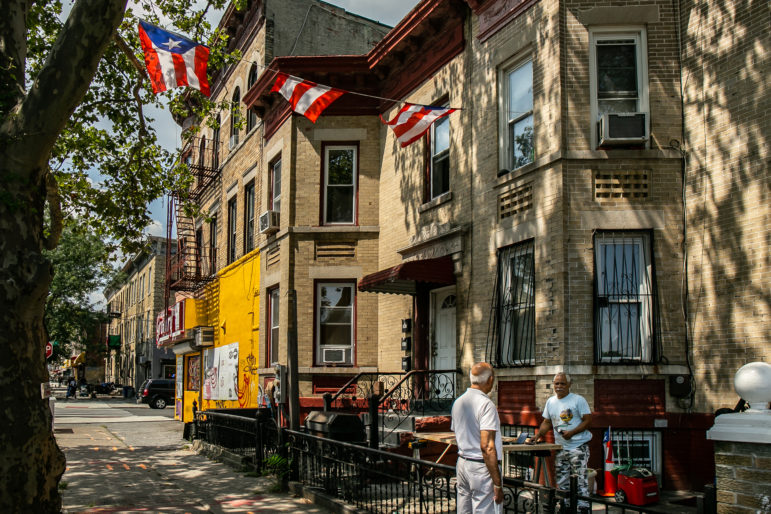
Adi Talwar
Homes along Knickerbocker Avenue in Bushwick.
When Mayor de Blasio unveiled his housing plan in 2014, he made clear his intent to rezone a number of neighborhoods for increased housing density. After 12 years of Bloomberg-style planning, where existing residents were cast to the side in favor of wealthier newcomers with little regard for the consequences, we were skeptical and concerned about this approach. However, the Mayor promised that this administration would be different. Rezonings would be done in a grassroots partnership with communities.
We took this commitment to heart when we began a planning process to envision Bushwick’s future. For five years, community residents and stakeholders worked tirelessly to craft the Bushwick Community Plan (BCP), a document that reflects the principles and priorities of the neighborhood. This document was published in September of 2018 and we made a commitment to the community to implement it.
The final result of the BCP did not match up with the Mayor’s vision of increasing housing supply. We have seen that large-scale residential developments become vehicles for the rapid displacement of our neighbors, putting his vision at odds with the needs of the community. The BCP’s primary goal is to guarantee that those who worked hard to put Bushwick on the map can afford to stay here.
The process to put together the BCP was community-based. Residents spent their nights and weekends documenting what needed protection and preservation, and what needed additional support and investment. This was a plan created by and for Bushwick. All final decisions were made by a steering committee, a body in which no elected official or agency acted as a voting member. This committee frequently reported back to the community and all its meetings were public. A lot of the feedback that was collected went further than land use and height restrictions. We wanted to ensure that we were actually planning, not just zoning. It took five years of hard work and constant engagement to get the BCP to reflect this. The community plan outlines recommendations for housing, zoning and land use, historic preservation, economic development, transportation and infrastructure, community health and resources, and open space. Under each of these topics are detailed recommendations for improving not just the built environment, but the overall social and physical health of the community.
The Department of City Planning (DCP) could easily have chosen to implement the BCP in its entirety. But instead they chose to put forth an alternative plan, which violated each of the land use principles put forth by the community. They omitted key elements of the plan, such as the preservation of the row houses in residential areas, restricting the conversion of local manufacturing land to housing, and ensuring that any additional housing units built beyond what is allowed under the current zoning are deeply affordable.
By putting forth their own plan, DCP cast aside five years of community work. They indicated that the City’s vision, drafted and planned by bureaucrats who have never lived here, should take priority over that of the local community. This is simply unacceptable.
The Bushwick rezoning is currently working its way through the environmental review process. At the City’s scoping hearing in June, each of us, along with dozens of residents and stakeholders, demanded that DCP study the BCP as an alternative to the City’s plan. If the City insists on putting in the work to study the implementation of its own plan, the least it could do for the community is consider the one they spent five years creating. Bushwick provides an opportunity for the de Blasio administration to renew its commitment to community planning, demonstrate how zoning can be used to protect a neighborhood from gentrification instead of catalyzing it, and affirm the importance of local voices.
We will not stop fighting for the BCP. The people of Bushwick have endured the trauma of displacement for far too long. They have sunk five years of hard work into creating a level of self-determination for their community. It is time for the City to respect their experience and work and implement the BCP.
Antonio Reynoso is the city council member for the 34th Council District, representing Bushwick and Williamsburg in Brooklyn and Ridgewood in Queens. Rafael Espinal is the representative for the 37th Council District, representing East New York, Cypress Hills, Bushwick and Brownsville.









3 thoughts on “Opinion: In Bushwick Rezoning, City Should Implement Community’s Own Plan”
Pingback: Briefly Noted: Rezone, Privatize, Rethink + Dolphins - BKLYNER
I didn’t take part in the BCP. Neither did many of my neighbors. Our voices would not have been respected. One of the core assets we have in America is freedom of mobility. I can live where I want, as long as I can afford the housing market and get a job to support my lifestyle. It doesn’t matter what color I am or what my ethnicity is. And no one can stop me. Not if I’m brown or white or polka dotted. There is a narrative of “displacement” which is antithetical to reality. Neighborhoods change, markets change. People move around based on jobs, weather, lifestyle changes…. and rising rents or lowering qualities of life (Bushwick in the 1980s saw the long time Italian and German residents depart). The narrative that the current majority population somehow deserves more because they have been there longer is appallingly arrogant. Are they Native American? We demand the DCP strike a balance and factor in all the voices of the community – not just the BCP.
Amen. I have lived in Bushwick for the last 4 years and never heard anything about this plan. Saying we all had a hand in shaping it is ridiculous. Also saying that local officials had no say is counter to this opinion piece written by two elected officials. I want my neighborhood to get better. I want the streets to not be littered with trash. Maybe these two can focus on that? Seems an easier problem to tackle.